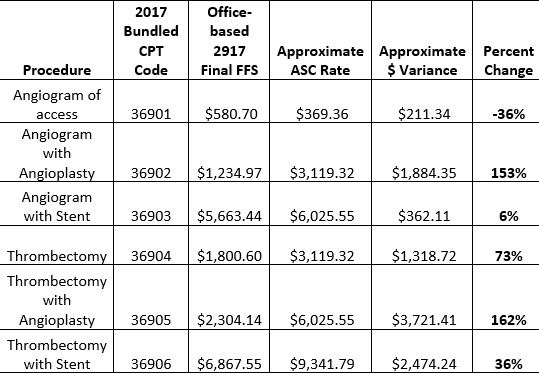Based on the multitude of positive benefits associated with ASCs, the growth of Office-Based Labs (OBLs), seems to be a logical transition and normal migration for outpatient endovascular care.
Following CMS’ approval for arterial endovascular interventions performed in outpatient centers, there has been explosive growth of OBLs throughout the US. It’s estimated that over 500 OBLs are operating with approximately 25 new centers opening each month.
Several specialties practice in the OBL setting, but the most common are Interventional Cardiology, Vascular Surgery, Radiology, and Interventional Nephrology. Procedure mix varies greatly, but most cases performed are interventions for peripheral artery disease (PAD), interventional radiology, and dialysis work.
Growth has been accelerated by significant advances in minimally invasive vascular procedures, and devices which in turn enhance efficiency and safety of various vascular procedures performed in the OBL. Almost all peripheral diagnostic and interventional procedures, from peripheral atherectomy to stenting and dialysis work like fistulagrams, thrombectomy, and angioplasty are performed in this setting.
CMS changes in reimbursement
Dialysis vascular access services, performed in vascular access centers (VACs) experienced a dramatic overall reduction in reimbursement in 2017. This is due to a CMS policy requiring services that are billed together more than 75% of the time to be bundled. As a result, the following new interventional CPT code bundles were developed and are highlighted below showing the approximate difference in reimbursement for certain interventional dialysis vascular access services performed in a VAC as compared to the same services performed in an ASC setting.

These cuts, have led many nephrology practices to consider the financial, operational and legal viability of converting their office based vascular access centers (VAC) into Hybrid ASCs.
The Ambulatory Cardiovascular Center
The Ambulatory Cardiovascular Center can be set up as a brand-new surgery center in the same building as the OBL or contiguous with the office, depending on regulations and the configuration of the current facility. It is a requirement by Medicare to get certified, licensed and accredited as an ASC; and in some states to obtain a Certificate of Need (CON). It is also necessary to remain an accredited OBL to access both reimbursement structures which makes this model so attractive. Cases can be scheduled to best maximize reimbursement by operating as an OBL on certain days of the week and an ASC on other days.
Jason Gries a partner at McGurieWoods LLP has a process map for evaluating whether to convert an OBL to a Hybrid ASC: “The first step is whether your OBL is significantly adversely impacted by recent CMS rate cuts. Second, is an evaluation of the costs to convert to an ASC, third is the estimated conversion timeline. Finally, the legal considerations must be evaluated.” If this analysis point to a conversion, then it’s time to start the pre-development process.
In the landmark 2016 book, Developing & Managing Ambulatory Surgery Centers, ASC industry experts Joseph and Robert Zasa state: “Planners should develop ASCs around four basic management cornerstones — patient care, risk management, business office and payer contracting.” They continue "Most ASCs are successes or failures before they're built. Certainly, there are exceptions. The point is that planning is absolutely critical to long-term success."
Several presentations at the recent OEIS (Outpatient Endovascular and Interventional Society) meeting revealed that approximately 25% of OBLs fail, and almost half are struggling. This is primarily due to inadequate planning on the front end with a lack of understanding about the business and market dynamics, case volume implications, and the proper reimbursement mix for the center to make the venture profitable.
Drawing from more than 35 years of experience in ambulatory surgery center development, and understanding the trends in health care, ACA Cardiovascular offers a well-tested approach to evaluating the potential success of an Ambulatory Cardiovascular Center. The approach evaluates the case mix, Medicare and private payor reimbursement for that specific zip code, and the local competition. These data points are analyzed and used to create the business plan which will highlight the advantages of this model.
This evaluation enables physicians to properly analyze the financial impact of developing an Ambulatory Cardiovascular Center, which both maximizes the reimbursement and allows the possibility of adding other specialties to further stabilize and or grow the business. A pre-development approach should always be used prior to the opening of a new or converted center to ensure financial viability.
In conclusion, the Ambulatory Cardiovascular Center offers a better experience to patients and physicians, lower costs to payors, and offers physician entrepreneurs freedom to operate and provide excellent patient care. Converting to this model widens the scope of practice and offers the ability to operate a specialized center for delivering innovative healthcare. With proper planning, a pre-development strategy and solid business plan, the Ambulatory Cardiovascular Center is the next wave of delivering high quality Endovascular, Cardiology and Dialysis Vascular Access therapy to patients.
The views, opinions and positions expressed within these guest posts are those of the author alone and do not represent those of Becker's Hospital Review/Becker's Healthcare. The accuracy, completeness and validity of any statements made within this article are not guaranteed. We accept no liability for any errors, omissions or representations. The copyright of this content belongs to the author and any liability with regards to infringement of intellectual property rights remains with them.


